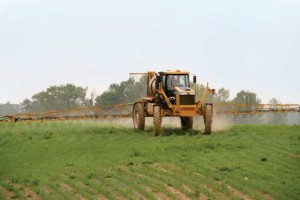Getting Adjuvant Certified

Adjuvants provide important benefits to applicators by improving pesticide spreading, wetting, canopy and leaf penetration and adhesion.
The Council of Producers & Distributors of Agrotechnology (CPDA) launched a certification program in 2001 for spray tank adjuvants to provide standard definitions and procedures to enhance product and label uniformity, consistency and quality. The program consists of 17 standards that are based on ASTM International guidelines, definitions and methodologies. Currently, there are more than 65 products licensed to display the “CPDA Certified” logo on their labels and marketing materials. Registrants and users of adjuvants bearing the CPDA certification logo can be assured that the product conforms to specific product claims, EPA requirements and good management and stewardship practices.
Before the CPDA Adjuvant Certification Program was instituted, there was little, if any, consistency in the quality and performance of adjuvants. Moreover, guarantees that an adjuvant product would live up to its purported functionality claim were virtually non-existent. Throughout the 1980s, the reputation of tank mix adjuvants suffered due to the lack of standardized definitions, inadequate information pertaining to the safe handling and use of these products, the absence of uniform composition guidelines and unsubstantiated performance claims. Pesticide manufacturers and users found themselves navigating a “wild west” of product claims with little reliable information to aid them in assessing the performance of tank mix adjuvants and ultimately, a lack of confidence in these products.
CPDA recognized that to begin to instill user confidence in these products, the adjuvant industry would have to adopt better quality controls and good management practices. Consequently, CPDA took a pro-active approach and worked diligently to develop a program that would identify products that meet specific scientific, technical and stewardship standards.
A History Of ASTM/CPDA Adjuvant Standardization
In October 1990, the ASTM E35.22 Subcommittee on Pesticides and Formulation Systems created a Task Force to define terms related to tank mix adjuvants. CPDA responded by forming its Adjuvants & Inerts Committee in 1991 to develop standards for those adjuvants that would be based on scientifically supported ASTM terminology. Starting in 1993 with the broad definition of an adjuvant as “a material added to a tank mix to aid or modify the action of an agrichemical or the physical characteristics of the mixture,” the ASTM Standard of Terminology relating to tank mix adjuvants (E1519) now consists of more than 70 terms and definitions that provide the scientific foundation of the CPDA Adjuvant Certification Program.
Today, these terms and definitions are also used by various state governments, such as Washington and California, in the regulatory approval of adjuvants. Similarly, the Standard of Terminology for pesticides (ASTM E609), also developed by the ASTM E35.22 subcommittee, has been incorporated into the CPDA adjuvant standards.
What The Adjuvant Standards Do
The CPDA adjuvant certification standards are intended to: 1) Establish minimum benchmarks for good product stewardship; 2) Ensure the use of EPA approved inerts in adjuvant formulations; 3) Establish good product communication guidelines; 4) Assure product performance claims meet ASTM functionality definitions; and 5) Provide the end user with information needed to make an informed product choice.
The adjuvant standards were not intended to establish efficacy or regulate the claims made by the manufacturer or differentiate products in the marketplace as acceptable or not acceptable, nor do they require extensive toxicology testing of products.
How To Obtain CPDA Certification Of An Adjuvant Product
Any company that manufactures or imports an adjuvant may apply for certification. Companies do not have to be a member of CPDA to participate in the certification program. An applicant must submit an application to CPDA’s Certification Committee, which includes specified information about the product and the applicant’s verification that the product complies with all applicable certification standards. Once the submission is approved by the CPDA Certification Committee, the applicant will be licensed under a certification license agreement to display the Certification Seal on the product’s label and promotional materials.
The entire review process generally takes 90 days from submission of the application to completion of review and notice of product certification. The License Agreement is effective for three years, after which the manufacturer must obtain product re-certification to continue use of the Certification Seal for another three-year period. Re-certification is also required if a chemical or compositional change of the product impacts one or more of the certification standards, or if new information or manufacturing changes impacts the toxicity profile of the product.
Changing Regulatory Requirements And Review Of Certified Products
The CPDA certification standards include certain federal regulatory requirements and, therefore, companies licensed to display the Certification Seal on their products may periodically be obligated to make changes to their products or labels to remain in compliance with the certification standards. For instance, adjuvant product labeling will be impacted by the U.S. Occupational Safety and Health Administration’s final rule modifying its Hazard Communication Standard to conform to the Globally Harmonized System of Classification and Labeling of Chemicals. Under this rule, the hazard signal word “caution” will no longer be allowed on the labels of adjuvants and agrochemicals that are not regulated under the Federal Insecticide, Fungicide, and Rodenticide Act (FIFRA) after June 1, 2015.
CPDA typically notifies companies participating in the certification program of such changes. In addition, although the EPA does not regulate spray tank adjuvants under FIFRA, some states do regulate them to varying degrees. Thus, all state labels that will display the Certification Seal must be reviewed by the CPDA Certification Committee prior to use of the Certification Seal on a state label.
EPA Approval Of Label Language Recommending Use Of A CPDA Certified Adjuvant
In 2006, EPA approved label language for recommending the use of a CPDA certified adjuvant on a pesticide product. In 2012, EPA confirmed that registrants could change the CPDA name on the label from “Chemical Producers and Distributors Association” to “Council of Producers & Distributors of Agrotechnology” without having to submit a formal notification to the agency. The current EPA-approved recommendation statement is: “When an adjuvant is to be used with this product, [name of the registrant of the pesticide] recommends the use of a Council of Producers & Distributors of Agrotechnology certified adjuvant.”
The certification program has been embraced by pesticide manufacturers as shown by their increasing use of this EPA-approved pesticide product label language recommending use of a CPDA certified adjuvant in combination with their pesticide products.
Advantages Of Using A CPDA Certified Adjuvant
Adjuvants provide important benefits to applicators by improving pesticide spreading, wetting, canopy and leaf penetration and adhesion. Adjuvants also have the potential to decrease the number of pesticide applications needed, reduce pesticide drift, eliminate foaming problems in spray tank mixtures, provide acidification to reduce alkaline hydrolysis and reduce unintended pesticide exposures.
Pesticide registrants and applicators using a CPDA certified adjuvant can be confident in knowing that:
- Product functionality claims meet ASTM standard definitions.
- Ingredients used in the product are EPA approved for use in pesticide formulations.
- EPA product labeling guidelines have been followed.
- Generic label descriptions include and guarantee the quantity of each principal functioning agent present.
For a complete list of certified adjuvants and to learn more about the CPDA adjuvant certification program, visit the CPDA Website at www.cpda.com.






